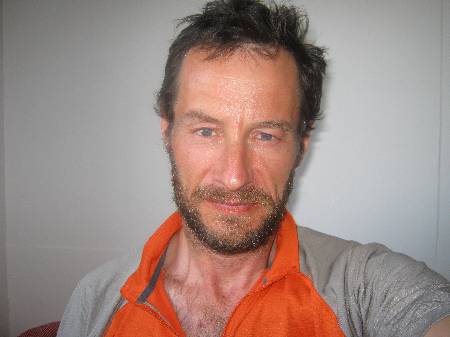
Thank you for keeping up with our expedition, it made it
Qaanaaq
First, I learned today that the spill in the gulf is still raging. It is a characteristic of being cut off for extended weeks that you tend to remake the world in your head. One thing I would never had imagined getting so wrong was seeing that oil still pouring out of its gash, at the rate of a million gallons a day; and the criminal consequences on the ecosystems and communities. It is devastating to witness so abhorrently a tragedy that was as predictable. I hope this lesson will be heeded once and for all: it is a dramatic cry for a commitment to a market transformation towards renewable energies. Our survival–quite literally–depends on it…
Tomorrow morning, we leave Qaanaaq–its bay of the sleeping giants, where icebergs feel trapped in time as much as space; its rolling ice fogs; its howling dogs; its colorful stock houses; and the arresting visual panorama which has been my view from the bedroom window for the last four days (a cross between Ice Age and The Day After Tomorrow!). And with that–I am compelled to say–comes the end of the entertainment portion of our program!
Eric and I are headed to Ilulissat, in transit back to our respective lives, which effectively puts an end to the expedition, and its Qaanaaq epilogue. I will spend a couple of days scouting the Disko Bay icefjord for more photos opportunity in view of my next book. The Ilulissat glacier is one of the most active in the northern hemisphere, spitting out enormous icebergs (some measure well over three hundred feet high–above the water line!) like a giant ice cube dispenser…
Then will come time to inventory, catalogue and organize the mass of content accumulated over the trip. Luckily–and thanks to modern technology–all my content is captured on flash cards. All 230 gigabytes of it–eighty percent of it filmed in view of a documentary retracing our adventure.
To that effect, a word of technical specs.
Like many expeditions, this was an equipment intensive mission. I am privileged to benefit from relationships with whom I consider are the best in the business in their respective fields.
I use HP technology for both my mini laptop and iPaqs/Smart phones. The mini was invaluable and survived extraordinarily harsh condition, especially the blender-like shake of moving over sastruga at high speeds; it performed flawlessly.
I would not know how to communicate blogs or transmit photos without the iPack which is the golden standard in the expedition bloggersphere. It is hooked to an Iridium satellite phone by way of a software created by Human Edge Tech’s Contact 5.
Expedition outfits were designed and provided by Napapijri who sets the standard in adventure wear, mixing durability and style. Their clothes took me to the North Pole and across 2300 kilometers of Greenland and will take whatever you throw at them, including eighty mile hour winds!
The S86 Rossignol skis were perfect on this mission, and for all kite skiing in general: they are light, with a good flex to feel the terrain without sacrificing the edge’s bite, so crucial in kiting. A great backcountry ski. No one makes better skis than Rossi.
We used Dynafit systems for boots and binding, simply for the weight: the boots are the lightest in the world which may not always be what you want, but on an expedition it is what you need. Besides, with an independent heel and toe mechanism, they are designed as a convertible allowing the switch from pulling (with skins) to full on downhill set up, saving you the weight of adding cross country skis to the load. It’s a great backcountry set up.
For kites, Ozone is the gold standard in kite-skiing concepts. They are the ones other companies watch for ideas. We used the Yakuzas, the Mantas and the Frenzys (in 14, 10 and 7 meters respectively). The Yakuzas were our bread and butter, rigged with extended lines–mine were on 75 meters (watch out for those knots on long lines–aaaargh!)
I had seven cameras with me. My two trusted Canon 5D Mark II’s which follow me everywhere. A better digital 35mm camera you will not find, especially as it doubles as the most pristine 1080 HD video capture I have seen. I use three zooms: 16-35, 24-70 and 100-400. I also had a Sony HD Handycam specifically for the video zoom, and the night vision feature which was planned for use at DYE II given the low light of its interior.
For action capture, I use the GoPros which have specific, but remarkable stunt HD applications. You can mount these anywhere!
Additionally, I had a couple of small Canon point-and-shoots for blog updates.
I use Lexar cards simply because they are the best and have never failed me, even in the most punishing environments. I had almost three hundred gigabytes in cards. After Ilulissat, I might come close to shooting it out!
Our trip was made carbon neutral, as is my life, by Climate Partner. MySpace provided designs and coverage, facilitating getting the word out on the trip and our milestones.
Finally, this adventure, as did my North Pole mission, benefited from the generous support of my friend Lawrence Benenson–thank you!
Just as importantly, your readership provided me with the incentive to write daily updates–you were the drive behind the effort. Thank you for keeping up with the adventure; it would be meaningless without you!
I will be headed to the South Pole in November to commemorate the Amundsen/Scott centennial. I hope you will join me there. It promises to be one hell of a trip: to the pole and back unsupported over an anticipated 80 days…
Look for some words from Ilulissat, and some picture: I won’t let you off so easy!

